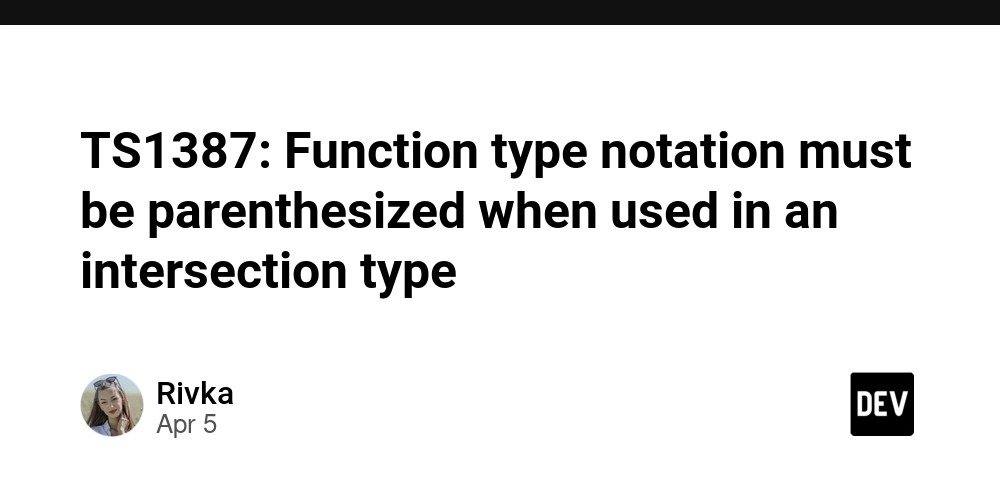TS1387: Function type notation must be parenthesized when used in an intersection type
TS1387: Function type notation must be parenthesized when used in an intersection type TypeScript is a powerful programming language that builds on JavaScript by adding static types. This means that TypeScript allows developers to define the types of variables, function parameters, and return values, making the code more predictable and robust. Types (which specify the structure and types of values) help catch errors at compile time instead of runtime, reducing bugs and improving code quality. If you want to learn more about TypeScript or use AI tools like gpteach to learn how to code, be sure to subscribe to my blog! Superset Language TypeScript is often referred to as a "superset" of JavaScript. This simply means that TypeScript includes all JavaScript features and adds additional capabilities, such as static types. You can think of it as an enhanced version of JavaScript that checks the types during development, making it easier to catch mistakes before running the code. Now, let's dive into our main topic: TS1387: Function type notation must be parenthesized when used in an intersection type. TS1387: Function type notation must be parenthesized when used in an intersection type In TypeScript, when you are creating an intersection type that includes a function type, it's crucial to use parentheses around the function type notation. Failing to do so will trigger a compilation error: TS1387. Understanding the Error The error TS1387: Function type notation must be parenthesized when used in an intersection type occurs because TypeScript requires clarity in defining intersection types, particularly when function types are involved. Without parentheses, the TypeScript compiler may misinterpret the intended type structure. Example of the Error Consider the following code snippet that defines an intersection type without parentheses: type A = { name: string }; type B = { age: number }; type C = A & B & (x: string) => void; // This will cause TS1387 In this example, you see that C is attempting to define an intersection of an object with a function, but it's not using parentheses around the function type. This will lead to the TS1387 error. Fixing the Error To resolve this error, you should wrap the function type notation in parentheses as shown: type A = { name: string }; type B = { age: number }; type C = A & B & ((x: string) => void); // Correct usage with parentheses Now the intersection type C is correctly defined, and TypeScript can properly interpret it, allowing you to use this type in your code without any errors. Important to Know! Types and Interfaces: When creating complex types in TypeScript, remember that functions are also first-class citizens. Their type definitions must be clear to avoid errors. Parentheses Matter: Always use parentheses when defining function types in intersection types. This simple practice prevents errors like TS1387. Compiler Awareness: Keep an eye on the TypeScript compiler's error messages; they often provide valuable information about where and why your code has issues. FAQs Q: What happens if I don’t use parentheses? A: You will encounter the TS1387 error, indicating that the compiler is confused about your type definition. Q: Are there any other situations where parentheses are needed? A: Yes! Parentheses are often needed in other complex type definitions, such as union types or when defining generic types. Q: Can I use functions in intersection types commonly? A: Absolutely! Functions can be part of intersection types, but just ensure to wrap them in parentheses to avoid errors like TS1387. In conclusion, understanding the nuances of TypeScript can greatly enhance your coding experience. Remember the importance of adding parentheses when defining function types in intersection types to prevent the TS1387: Function type notation must be parenthesized when used in an intersection type error. With practice, these conventions will become second nature. Happy coding!

TS1387: Function type notation must be parenthesized when used in an intersection type
TypeScript is a powerful programming language that builds on JavaScript by adding static types. This means that TypeScript allows developers to define the types of variables, function parameters, and return values, making the code more predictable and robust. Types (which specify the structure and types of values) help catch errors at compile time instead of runtime, reducing bugs and improving code quality.
If you want to learn more about TypeScript or use AI tools like gpteach to learn how to code, be sure to subscribe to my blog!
Superset Language
TypeScript is often referred to as a "superset" of JavaScript. This simply means that TypeScript includes all JavaScript features and adds additional capabilities, such as static types. You can think of it as an enhanced version of JavaScript that checks the types during development, making it easier to catch mistakes before running the code.
Now, let's dive into our main topic: TS1387: Function type notation must be parenthesized when used in an intersection type.
TS1387: Function type notation must be parenthesized when used in an intersection type
In TypeScript, when you are creating an intersection type that includes a function type, it's crucial to use parentheses around the function type notation. Failing to do so will trigger a compilation error: TS1387.
Understanding the Error
The error TS1387: Function type notation must be parenthesized when used in an intersection type occurs because TypeScript requires clarity in defining intersection types, particularly when function types are involved. Without parentheses, the TypeScript compiler may misinterpret the intended type structure.
Example of the Error
Consider the following code snippet that defines an intersection type without parentheses:
type A = { name: string };
type B = { age: number };
type C = A & B & (x: string) => void; // This will cause TS1387
In this example, you see that C is attempting to define an intersection of an object with a function, but it's not using parentheses around the function type. This will lead to the TS1387 error.
Fixing the Error
To resolve this error, you should wrap the function type notation in parentheses as shown:
type A = { name: string };
type B = { age: number };
type C = A & B & ((x: string) => void); // Correct usage with parentheses
Now the intersection type C is correctly defined, and TypeScript can properly interpret it, allowing you to use this type in your code without any errors.
Important to Know!
- Types and Interfaces: When creating complex types in TypeScript, remember that functions are also first-class citizens. Their type definitions must be clear to avoid errors.
- Parentheses Matter: Always use parentheses when defining function types in intersection types. This simple practice prevents errors like TS1387.
- Compiler Awareness: Keep an eye on the TypeScript compiler's error messages; they often provide valuable information about where and why your code has issues.
FAQs
Q: What happens if I don’t use parentheses?
A: You will encounter the TS1387 error, indicating that the compiler is confused about your type definition.
Q: Are there any other situations where parentheses are needed?
A: Yes! Parentheses are often needed in other complex type definitions, such as union types or when defining generic types.
Q: Can I use functions in intersection types commonly?
A: Absolutely! Functions can be part of intersection types, but just ensure to wrap them in parentheses to avoid errors like TS1387.
In conclusion, understanding the nuances of TypeScript can greatly enhance your coding experience. Remember the importance of adding parentheses when defining function types in intersection types to prevent the TS1387: Function type notation must be parenthesized when used in an intersection type error. With practice, these conventions will become second nature. Happy coding!











































































































































































![[The AI Show Episode 142]: ChatGPT’s New Image Generator, Studio Ghibli Craze and Backlash, Gemini 2.5, OpenAI Academy, 4o Updates, Vibe Marketing & xAI Acquires X](https://www.marketingaiinstitute.com/hubfs/ep%20142%20cover.png)




























































































































![[DEALS] The Premium Learn to Code Certification Bundle (97% off) & Other Deals Up To 98% Off – Offers End Soon!](https://www.javacodegeeks.com/wp-content/uploads/2012/12/jcg-logo.jpg)


![From drop-out to software architect with Jason Lengstorf [Podcast #167]](https://cdn.hashnode.com/res/hashnode/image/upload/v1743796461357/f3d19cd7-e6f5-4d7c-8bfc-eb974bc8da68.png?#)








































































































.png?#)

































_Christophe_Coat_Alamy.jpg?#)
 (1).webp?#)





































































































![Apple Considers Delaying Smart Home Hub Until 2026 [Gurman]](https://www.iclarified.com/images/news/96946/96946/96946-640.jpg)
![iPhone 17 Pro Won't Feature Two-Toned Back [Gurman]](https://www.iclarified.com/images/news/96944/96944/96944-640.jpg)
![Tariffs Threaten Apple's $999 iPhone Price Point in the U.S. [Gurman]](https://www.iclarified.com/images/news/96943/96943/96943-640.jpg)




































































































































